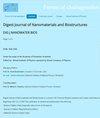The difference in the type of zinc oxide nanostructures depending on the growth layer
IF 1
4区 材料科学
Q4 MATERIALS SCIENCE, MULTIDISCIPLINARY
Digest Journal of Nanomaterials and Biostructures
Pub Date : 2023-07-20
DOI:10.15251/djnb.2023.183.793
引用次数: 0
Abstract
In this study, RF-sputtering was used to hydrothermally produce zinc oxide nanorods (ZnO NRs) on the seed layer of ZnO/Glass substrates. at different thicknesses (t1 = 1135 nm, t2 = 1306 nm, t3 = 1437 nm, t4 = 1533 nm). The structural properties were studied by X-ray diffraction, which showed that ZnO NRs and the seed layer films are polycrystalline with the same preferred reflection for the (002) plane, and the grain size of the seed layer ranges between 19.51 nm and 30.45 nm for thicknesses t1 and t4, respectively. The measurements of the FESEM showed aspect ratios for ZnO NRs ranging from 3.03 for t1 to 4.9 for t4, with growth in different shapes: ZnO NR rods for t1, flowers and rod-like shapes for thicknesses of t2 and t3, and hexagonal-rod-like shapes in t4. Optical measurements showed a decrease in the transmittance and an increase in the energy gap values with increasing thickness.氧化锌纳米结构类型的不同取决于生长层
在本研究中,使用RF溅射在ZnO/玻璃衬底的种子层上水热制备氧化锌纳米棒(ZnO-NRs)。在不同的厚度(t1=1135nm,t2=1306nm,t3=1437nm,t4=1533nm)。通过X射线衍射研究了结构性能,结果表明ZnO NRs和种子层膜是多晶的,对于(002)平面具有相同的优选反射,并且对于厚度t1和t4,种子层的晶粒尺寸分别在19.51nm和30.45nm之间。FESEM的测量显示,ZnO NR的纵横比在t1的3.03到t4的4.9之间,生长为不同的形状:t1的ZnO NR棒,厚度为t2和t3的花和棒状,以及t4的六边形棒状。光学测量显示,随着厚度的增加,透射率降低,能隙值增加。
本文章由计算机程序翻译,如有差异,请以英文原文为准。
求助全文
约1分钟内获得全文
求助全文
来源期刊

Digest Journal of Nanomaterials and Biostructures
工程技术-材料科学:综合
CiteScore
1.50
自引率
22.20%
发文量
116
审稿时长
4.3 months
期刊介绍:
Under the aegis of the Academy of Romanian Scientists
Edited by: -Virtual Institute of Physics operated by Virtual Company of Physics.
 求助内容:
求助内容: 应助结果提醒方式:
应助结果提醒方式:


